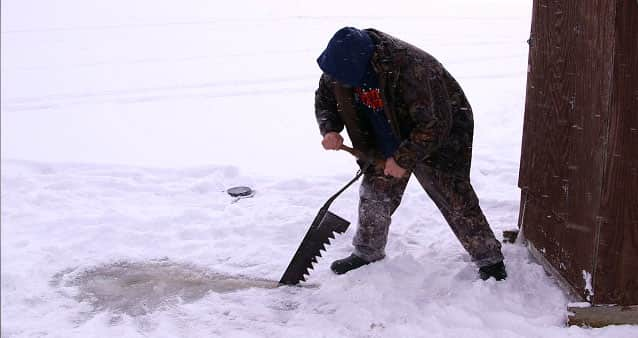Spearfishing Makes Triumphant Return to Houghton Lake
Steve Griffin 12.07.12

Of all the Michigan lakes that anglers are watching for the formation of ice, likely none are getting the anxious attention focused on Houghton Lake.
A certain type of angler is looking at (or rather, eager to look into) what is by surface area the state’s largest inland lake. Whenever the ice fishing season opens–and that’s determined by a sometimes fickle Mother Nature–it will usher in the first northern pike spearing season on this lake since 1939.
A grand irony in this long-standing ban on a fishing style enjoyed on nearly all other Michigan lakes is this: nobody knows why it was placed on Houghton Lake.
Not DNR officials, asserts Christian LeSage of that agency’s Fisheries Division.
“It’s unclear what led the Legislature to ban it back then,” LeSage said.
Not local anglers, not sporting goods stores.
“Nobody seems to know why,” said Jeff Dow, of Lyman’s on the Lake, one of Houghton Lake’s top shops.

But somehow, state legislators were moved to kick off-lake the what are now called darkhouse anglers–spearers–leaving only hook-and-line legal on the lake that became Tip-Up Town, U.S.A.
Now, following passage this year of Public Act 245, and signing of the DNR’s Fisheries Order 219, Houghton Lake is open for spearing again. The Act and Order also add crossbows to the list of acceptable gear wherever bow and arrow may be used, and shortens the list of lakes on which pike and muskellunge spearing is illegal.
Spearing has as much in common with hunting, particularly bowhunting, as with any other forms of fishing. The human predator watches, from above, for quarry to come into view, attracted by food or even curiosity. Give the predator-cum-prey a hint that there’s something amiss, whether by noise, vibration or light, and the game’s over. Otherwise, the human must identify the fish as a pike, longer than the minimum (on most lakes) 24 inches. And then, if it meets his or her standards besides, there comes the challenge of allowing for the refractive property of water, which makes things look like they are where they aren’t, and throwing the weighted spear.
It’s best explained to someone who’s just tossed an errant spear past a pike.
If you like tradition, there aren’t many older than a spear-wielding person watching a live or artificial decoy, waiting for it to draw a pike into view.
“A lot of our older customers, especially, say they haven’t been ice fishing in years but they’re champing at the bit to get out there (Houghton Lake) spearing now,” said Dow for a print story earlier this fall.
Some have called “fish TV” the hours spent watching the underwater, under-ice world from a perch (pun intended) above.

On Higgins Lake, just north of Houghton Lake and connected to it, we’ve speared pike in 18 feet of water–a long, long toss of the tines–depths they’ve shared with yellow perch, rainbow trout and even lake trout. We’ve caught perch with hook and line while waiting for a pike. But fair warning: you’re almost sure to be holding the wrong weapon when the toothy one arrives.
The shelter, often called a darkhouse or spearing coop, needs to be lightproof so that you can see the fish and it can’t see you. That, though, makes it nearly air-tight, too. For safety’s sake, take a break now and then, and open the door to let in fresh air. Some spearers have been overcome by carbon monoxide and tumbled into their own spearing holes to their death.
The through-ice spearing season began, at least theoretically, on December 1 and ends on March 15. In practice, it starts when the ice is thick enough to support one or two anglers in a light-proof shelter.
And this season, that shelter might just be on Houghton Lake.
For more information on Michigan fishing go to michigan.org.

